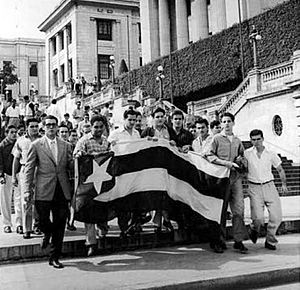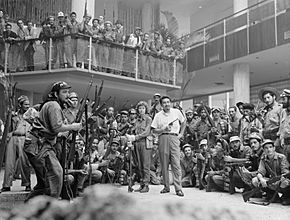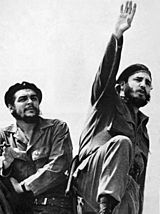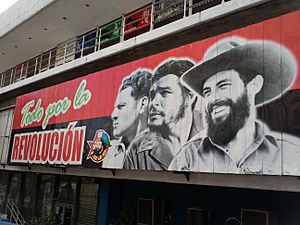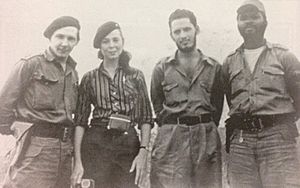Cuban Revolution facts for kids
Quick facts for kids Cuban Revolution |
|||||||
|---|---|---|---|---|---|---|---|
 Raúl Castro (left), with his arm around his second-in-command, Ernesto "Che" Guevara, in their Sierra de Cristal mountain stronghold in Oriente Province, Cuba, in 1958 |
|||||||
|
|||||||
| Belligerents | |||||||
|
|
Supported by: |
||||||
| Commanders and leaders | |||||||
| Strength | |||||||
| 20,000 (1958) | 3,000 (1958) | ||||||
| Casualties and losses | |||||||
| 2,000 killed
Arms captured: 1 M4 Sherman tank 12 mortars 2 bazookas 12 machine guns 21 light machine guns 142 M-1 rifles 200 Dominican Cristobal submachine guns |
1,000 killed | ||||||
| Thousands of dissidents arrested and murdered by Batista's government; unknown number of people executed by the Rebel Army | |||||||
The Cuban Revolution (Spanish: Revolución cubana) was an armed uprising led by Fidel Castro's 26th of July Movement. They fought against the government of Cuban President Fulgencio Batista, who ruled as a dictator. The revolution started in July 1953 and continued until the rebels finally removed Batista from power on December 31, 1958. January 1, 1959, marked the start of a new government in Cuba.
This revolution changed a lot in Cuba and how it related to other countries, especially the United States. After the revolution, Castro's government took control of many businesses and media. This completely changed Cuba's economy and society. The revolution also led to Cuba getting involved in military conflicts in other parts of the world, like Africa and Latin America.
Contents
Why the Revolution Started
Cuba's Government Before the Revolution
After gaining independence from the U.S. in 1902, Cuba faced many problems. There were revolts, military takeovers, and even times when the U.S. military occupied the country. Fulgencio Batista was a former soldier who had been president from 1940 to 1944. In 1952, he took power again through a military takeover, canceling elections that were supposed to happen.
During his second time in power, Batista became a harsh ruler. He didn't care much about what ordinary people needed. Cuba had high unemployment and poor water systems. Batista also made deals with organized crime and let American companies control much of Cuba's economy, especially sugar farms. Even though the U.S. supported Batista's government at first, later U.S. leaders realized how corrupt he was.
People Against Batista
Batista was strongly against communism. He tried to silence anyone who disagreed with him. In 1952, a young lawyer named Fidel Castro tried to legally challenge Batista's rule, calling him corrupt. But the Cuban courts rejected Castro's arguments.
Realizing he couldn't change the government legally, Castro decided to start an armed revolution. He and his brother Raúl Castro formed a group called "The Movement." They gathered weapons and recruited about 1,200 followers from working-class people in Havana who were unhappy with the government.
Early Days of the Fight
Attack on Moncada Barracks
On July 26, 1953, Fidel and Raúl Castro led 69 fighters in their first attack against Batista's government. They targeted the Moncada Barracks in Santiago de Cuba and another barracks in Bayamo. The government soldiers easily defeated them. The rebels had hoped this attack would start a country-wide uprising, but it failed.
Many rebels were killed, and others were captured and executed. Among those killed was Abel Santamaría, Castro's second-in-command, who was tortured and executed.
Prison and Exile
After the attack, many key revolutionaries, including the Castro brothers, were captured. During his trial, Fidel Castro spoke for almost four hours, defending himself. He famously ended with the words, "Condemn me, it does not matter. History will absolve me." He was sentenced to 15 years in prison, and Raúl got 13 years.
However, in 1955, due to public pressure, Batista's government released all political prisoners, including the Castro brothers. Soon after, the Castros went to Mexico to plan Batista's overthrow. There, Fidel met Argentine revolutionary Che Guevara, who joined their cause. The group named themselves the "26th of July Movement" to remember their first attack on the Moncada Barracks.
Student Protests
By late 1955, student protests and demonstrations became more common. Young people were seen as possible revolutionaries, and the government responded with increasing force. The University of Havana was even closed temporarily in November 1956 because of student opposition.
Another Barracks Attack
On April 29, 1956, another group of about 100 rebels, led by Reynol Garcia, attacked the Domingo Goicuria army barracks. This attack was also defeated, with rebels and soldiers killed.
The Conflict Grows
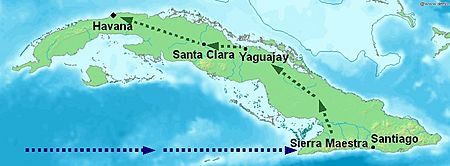
The Granma Landing
On November 25, 1956, the yacht Granma left Mexico carrying the Castro brothers, Che Guevara, Camilo Cienfuegos, and 80 others. The boat was meant for only 12 people, so it was very crowded. On December 2, they landed in Cuba.
After landing, the rebels headed into the Sierra Maestra mountains. But Batista's army attacked them. Most of the Granma participants were killed. Only about twenty of the original 82 men survived and escaped into the mountains. These survivors, including Fidel and Raúl Castro, Che Guevara, and Camilo Cienfuegos, formed the core of the new rebel army. Women revolutionaries like Celia Sanchez and Haydée Santamaría also helped Castro in the mountains.
Attack on the Presidential Palace
On March 13, 1957, a different group of revolutionaries, mostly students, stormed the Presidential Palace in Havana. They tried to kill Batista and overthrow the government. But the attack failed completely. Their leader, José Antonio Echeverría, was killed in a shootout.
Frank País's Death and a Strike
On July 20, 1957, rebel leader Frank País was captured and killed in Santiago de Cuba. During his funeral, activists marched through the city and started a general strike. This strike led to fights with the police and spread across different provinces for days.
Growing Rebel Strength and U.S. Involvement
The United States initially supplied Batista's government with planes, ships, and tanks. However, the U.S. later put an arms embargo on Cuba in 1958, which meant Batista could no longer get weapons from them. This greatly weakened his forces.
Batista's support among Cubans began to disappear. Many former supporters joined the revolutionaries or stopped supporting Batista. Batista's government often used harsh methods to control the cities. But in the Sierra Maestra mountains, Castro's forces, though small, won many battles against Batista's troops. They were helped by local fighters called escopeteros, who protected supply lines and shared information. Eventually, Castro gained control of the mountains.
The rebels also used propaganda. They set up a radio station called Radio Rebelde ("Rebel Radio") in February 1958. This allowed Castro to broadcast his message across the country.
Even though Castro's forces were small (sometimes fewer than 200 men) compared to the Cuban army (around 37,000), the army often had to retreat when they fought the revolutionaries.
Operation Verano
Batista finally launched a major attack on Castro's forces in the mountains, called Operation Verano. He sent about 12,000 soldiers into the mountains. But Castro's determined guerrillas defeated the Cuban army in a series of small battles. In the Battle of La Plata, Castro's forces defeated a 500-man battalion, capturing 240 soldiers while losing only three of their own.
On July 29, 1958, Batista's troops almost destroyed Castro's army of 300 men at the Battle of Las Mercedes. Castro asked for a temporary cease-fire, which he received. During the cease-fire, Castro's forces managed to escape the trap. By August 8, Castro's entire army was back in the mountains, and Operation Verano had failed for Batista.
Rebel Attack
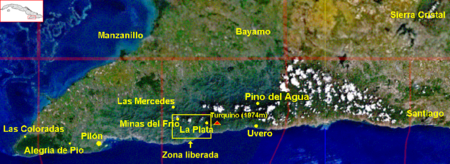
On August 21, 1958, after Batista's attack failed, Castro's forces began their own offensive. They came down from the mountains with new weapons. Castro's forces won several victories, taking control of the Cauto plains.
Meanwhile, three rebel groups, led by Che Guevara, Camilo Cienfuegos, and Jaime Vega, moved west towards Santa Clara. Batista's forces destroyed Jaime Vega's group, but the other two reached the central provinces. There, they joined other resistance groups. Even though there was some tension between Che Guevara's group and the Revolutionary Directorate forces, the combined rebel army continued fighting. Cienfuegos won a very important victory in the Battle of Yaguajay on December 30, 1958.
Battle of Santa Clara and Batista's Escape
On December 31, 1958, the Battle of Santa Clara took place. The city of Santa Clara fell to the combined forces of Che Guevara, Cienfuegos, and other rebel groups. When Batista heard about these defeats, he panicked. He fled Cuba by plane to the Dominican Republic just hours later, on January 1, 1959.
Rebel forces continued fighting, and by January 2, they had captured the city of Cienfuegos. Castro learned of Batista's flight and began negotiations to take over Santiago de Cuba. On January 2, Castro's forces took over Santiago. Guevara and Cienfuegos entered Havana around the same time without any resistance. Castro himself arrived in Havana on January 8 after a long victory march.
After the Revolution
Relations with the United States
The Cuban Revolution was a huge change in how the U.S. and Cuba related to each other. At first, the U.S. government was willing to recognize Castro's new government. But they soon worried that communist uprisings would spread in Latin America. Castro's government, on the other hand, was upset that the Americans had helped Batista during the revolution.
In August 1960, Castro's government took control of all U.S. property in Cuba. In response, the American government froze all Cuban money in the U.S., ended diplomatic ties, and made its trade ban against Cuba even stricter. In 1961, the U.S. government supported an armed attack on Cuba called the Bay of Pigs Invasion to try and remove Castro, but the Cuban military quickly defeated the attackers.
The U.S. embargo against Cuba is still in place today, making it the longest-lasting foreign policy in American history. While there were efforts to improve relations in the mid-2010s, many restrictions have been put back in place.
Global Impact
Castro's victory and Cuba's new foreign policy had a big impact around the world. Castro wanted to "export" his revolution to other countries. Cuba became very involved in supporting communist uprisings and independence movements in many developing countries. They sent military aid to rebels in places like Algeria, Nicaragua, Yemen, and Angola. For example, Cuba sent as many as 60,000 soldiers to the Angolan Civil War in the 1970s and 1980s.
Relations with the Soviet Union
After the American embargo, the Soviet Union became Cuba's main ally. The two countries, both communist, quickly formed close military and intelligence ties. This led to the Soviet Union placing nuclear weapons in Cuba in 1962, which caused the Cuban Missile Crisis. Cuba remained close to the Soviets until the Soviet Union broke apart in 1991. The end of Soviet aid caused a severe economic crisis in Cuba, known as the Special Period.
Key Features of the Revolution
Ideas Behind the Revolution
During the revolution, many different groups supported the movement, including communists, business leaders, and the Catholic Church.
Fidel Castro's exact beliefs during the revolution are still debated by historians. Some say he was a communist from the start, while others believe he didn't have strong political loyalties at first. Some historians point out his friendly relations with the U.S. right after the revolution as evidence that he wasn't a strong communist then.
At the time, the 26th of July Movement included people with different political views. But most agreed on wanting to bring back the 1940 Constitution of Cuba and supported the ideas of José Martí. Che Guevara once said that Fidel was not a communist, describing him and his movement as "revolutionary nationalist" and "anti-American" because the Americans were "anti-revolutionaries."
Women's Roles
Women played a very important part in the Cuban Revolution. They were involved from the attack on the Moncada Barracks to the Mariana Grajales Platoon, an all-women's group that protected Fidel Castro.
Tete Puebla, who was second in command of the Mariana Grajales Platoon, said that women were always at the front of the struggle. Before the Mariana Grajales Platoon, women in the Sierra Maestra mountains helped by cooking, mending clothes, caring for the sick, and acting as messengers. They also taught guerrillas to read and write.
Haydée Santamaría and Melba Hernandez were the only women in the Moncada Barracks attack. Afterward, they helped form alliances and distribute Castro's famous speech, "History Will Absolve Me." Celia Sanchez and Vilma Espin were important planners and skilled fighters throughout the revolution. Tete Puebla said that Celia Sanchez's ideas influenced almost everything in the Sierra.
In Popular Culture
- The Cuban Revolution, including Batista's escape, is a big part of the 1974 film The Godfather Part II.
- The 1987 video game Guevara (released as Guerrilla War in the U.S.) features Castro and Guevara fighting a dictator.
- The 2008 film Che, about Che Guevara, shows how Castro's movement grew and Guevara's role in the revolution.
- The 2013 strategic board game Cuba Libre lets players act out the conflict from the perspective of different groups involved in the Revolution.
Images for kids
See also
 In Spanish: Revolución cubana para niños
In Spanish: Revolución cubana para niños


